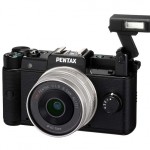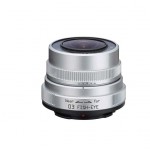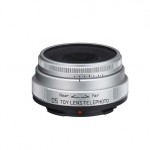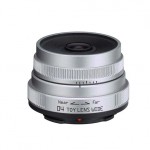
The Pentax Q is a new interchangeable lens camera system. What sets the Pentax Q apart from other interchangeable lens models, however, is that the Q sports a 12.4MP compact 1/2.3″ CMOS sensor – meaning that this camera is basically a glorified point and shoot camera.
That said, the Pentax Q still offers advantages over most other point and shoot cameras – like the ability to capture 12-bit raw images in Adobe’s DNG format, as well as JPEG files. Additionally, the Pentax Q allows you to maximize your focal length range with interchangeable wide angle and telephoto zoom lenses – as well as prime lenses with wide apertures for low light situations.
In order to combat the extended depth of field resulting from the ultra-small image sensor, Pentax has placed in-camera filters (dubbed “bokeh control filters”) in the Q camera, which allow you to manipulate the perceived depth of field.
The Pentax Q will also capture 1080p HD video, 3-frame HDR images and offers sensor-based image stabilization. Other key specs include a 3-inch, 460k-dot resolution LCD monitor, a 5fps frame rate and a sensitivity range of ISO 125-6400.
The Pentax Q kit retails for $799.95 and should be available in the US in Fall 2011. Check availability on Amazon.com.
While the Q kit includes the camera a 8.5mm f/1.9 lens (roughly 50mm equivalent taking into account the crop factor), the price seems a little on the steep side considering you can currently buy a Nikon D5100 with lens for $50 more than the Q. (And in the mirrorless department, you suffer a bit of a size penalty over the Q, but basically all of the other cameras will almost certainly offer better image quality for around the same price of a Q kit.)
Additional lenses will be available in for the Q system, including 27.5-83mm zoom equivalent ($300 retail) and a 160-degree fisheye ($130 retail), as well as a pair of 35mm and 100mm equivalent “toy camera” lenses ($80 retail each).
While Pentax has clearly created the “smallest ILC in the world,” the question remains as to whether anyone will want one. Size is certainly a consideration when marketing ILC (or “mirrorless”) cameras to the consumer audience; however, up until now we’ve only seen ILC cameras that rival DSLRs in overall image quality and performance. Will a glorified point and shoot “system” be able to compete in this market?



















For me: no way.
The price is too steep for what I get. While I applaud the DNG option I’m wondering if the market of buyers (assuming they even exist) will be the sort to shoot in RAW in the first place.
The Q, apart from being a styling failure, is a marketing disaster. A Point and Shoot family photographer is better off with a good zoom compact – why fiddle with interchangeable lenses? – and any enthusiast who is willing to accept a sensor smaller than APS-C probably already has a 4/3 camera. Sorry, Pentax. A compact mirrorless body, with KA lens mount and an eye-level viewfinder as well as the screen, would, I am sure, have sold well. I predict an early demise for a the Q and further trouble over Pentax within the Hoya Corporation. I hope I am wrong.
I’m inclined to agree with all your points John. I don’t quite see it over say a Canon G12 or similar camera…
Not sure sarcasm belongs in the headline. I’ve noticed a tendency to treat Pentax with sarcasm at this site. When I wrote headlines, they had to be neutral for non-editorial work.
I don’t agree with the fellows. I”ve been working and studying photography for the last 30 years and I have seen many interesting projects along this time. What is image quality at all? My Pentax 6×7 makes the best images I have ever made, but it”s quite useless in many situations. My Sony TX 10 makes wonderful images… Maybe a small sensor camera that can use several different lenses is wonderful for serious photographers who aim more the meaning of their images than number of lines per mm of resolution. Congratulatinos, Pentax, maybe this camera will join my old 6×7 as a jewel…
While it is true that content and meaning trump photographic quality, detail and smoothness are also desired and appreciated by the masses. I agree that a single high quality zoom is the default lens rather than a selection of special purpose lenses considering the inconvenience of changing lenses. I would have preferred a basic point and shoot camera with a full sized sensor and a 24 to 200mm zoom lens. The built in HDR is a great feature to retain.